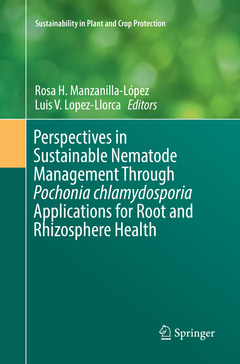Perspectives in Sustainable Nematode Management Through Pochonia chlamydosporia Applications for Root and Rhizosphere Health, Softcover reprint of the original 1st ed. 2017 Sustainability in Plant and Crop Protection Series
Coordonnateurs : Manzanilla-López Rosa H., Lopez-Llorca Luis V.

This volume reviews our current knowledge and novel research areas on Pochoniachlamydosporia, a cosmopolitan fungus occurring in soils as a saprophyte yet capable of colonizing the rhizosphere of crops as an endophyte and behaving as a parasite of eggs of plant-parasitic nematodes. The book is divided into six sections containing 18 chapters, starting with a historical background chapter, followed by 16 chapters, each contributed by experts, concerning those key aspects necessary to work with this biocontrol agent in a multidisciplinary treatise. Topics covered include systematics, biology, nematode-fungus interactions, nematode management strategies, secondary metabolites, and other methods including more novel research areas such as molecular, ?omics, plant growth enhancement and endophytic abilities of P. chlamydosporia. The final chapter deals with the future perspectives of P. chlamydosporia research.
Chapter 1 Introduction (Historical and Overview) - Ken Evans, Rosa H. Manzanilla-López and Luis V. Lopez-Llorca
Chapter 2 Systematics of Pochonia - Harry C. Evans and Paul M. Kirk
Section II: Bionomics
This book is a multidisciplinary treatise with contributions by experts presented in a single volume and concerning the biology, physiology, ecology, protocols for production, integrated pest management strategies compatibility with Pochonia chlamydosporia, and other practical aspects of P. chlamydosporia use
There is a growing interest in the biopesticides market on products based on Pochonia chlamydosporia formulations. This volume covers those key aspects necessary to work with this biocontrol agent.
The potential use of the fungus, not only as biological control agent but as a plant growth promoter and biofertilizer, will help to diversify the application of the fungus in crop management
The phasing-out of methyl bromide and nematicides has intensified the search for chemical or biological alternatives to maintain crop production under more strict policies to control pests and diseases using innovative environmentally friendly approaches for which Pochonia chlamydosporia is capable of playing an important role
Date de parution : 08-2018
Ouvrage de 411 p.
15.5x23.5 cm
Date de parution : 10-2017
Ouvrage de 411 p.
15.5x23.5 cm



